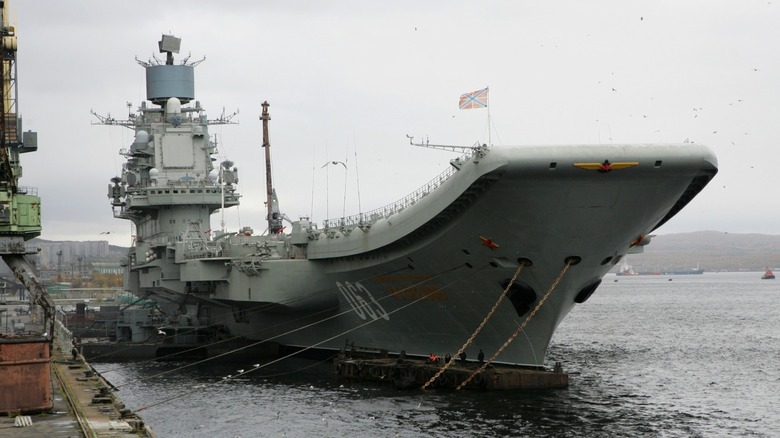
kojoku/Shutterstock
Russia is not a country many think of often when discussing aircraft carriers. While the Russian Federation has a single aircraft carrier, the Admiral Kuznetsov, it’s old, comparatively small, isn’t nuclear powered, and has been undergoing a much-needed refit since 2018. The United States has 11 aircraft carriers and is building more that are incomparably more advanced than the Kuznetsov, and Russia knows this all too well.
Russia announced plans to build a modern aircraft carrier in 2015, and given the claims, the supercarrier would be the largest ever built. The plan was called Project 23E000E and was intended to enter service by 2030. Ideally, the Russians would build a carrier comparable to the newest class of American ships, the Gerald R. Ford supercarrier, which was still in development at the time. According to Russia Beyond, upon making the announcement, Professor Vadim Kozyulin from the Academy of Military Sciences said, «It will be a floating airport that is accompanied by an entire squadron of ships.»
Kozyulin’s description is apt for something like the USS Gerald R. Ford, so Russia’s plans were comparable. The planned vessel, the Shtorm, would travel up to 30 mph; it would displace 100,000 tons of seawater and would be crewed by around 4,000 personnel. Additionally, the Shtorm would support up to 90 aircraft, matching the strength of a Ford-class American carrier. Russia’s planned carrier would cost some 350 billion to one trillion rubles.
[Featured image by LeAZ-1977 via Wikimedia Commons | Cropped and scaled | CC BY-SA 4.0]
The further development of Project 23E000E
Russia’s plans for the Shtorm were impressive, and while it appears the country still plans on building the vessel, the realities of Russia’s current situation make it unlikely to come to fruition as intended. Russia is under some of the most restrictive international sanctions ever imposed, thanks to its invasion of Ukraine. Because of this, Russia likely lacks the resources or finances to bring the Shtorm to reality.
Despite this, Russia continues its development program, and the project has evolved. Now, Russia plans on building a supercarrier that displaces 90,000 tons, but more than that, the nation modified the aircraft it wants to use on the carrier. Initially, the plan was to fill the Shtorm’s deck with MiG-29K fighters and the T-50 plane. Russia now wants to use a naval variant of the Su-57 Felon jet, which is a significantly more advanced fifth-generation fighter.
According to the Eurasia Times, Former Deputy Chief of the Main Staff of the Russian Navy, retired Vice Admiral Vladimir Pepelyaev, spoke to state-run news agency Ria Novosti about the plan in June 2024: «Our promising aircraft carrier should have a displacement of 70 to 90 thousand tons, but the most important thing is not the displacement, not air drones, but aircraft. Today, we have Su-33 and MiG-29K/Cube. In the future, our aircraft carrier should be armed with Su-57.»
What the future holds for Project 23E000E
Sanctions may have slowed down Russia’s plans to build a modern supercarrier, but they didn’t come to a screeching halt. The nation continues the development of Project 23E000E and still hopes to field a carrier as quickly as possible. Not long after announcing its plans, Russia offered the plans for its supercarrier to India, so there’s a chance another nation could build one before Russia does. Still, it’s unlikely India will fully develop the plans while it continues building its own native carriers.
Regardless, Russia continues developing Project 23E000E, and in 2020, there are reports that say that plans were put in place to outfit a future carrier with the S-500 Prometheus anti-aircraft missile system. As Russia updates and upgrades its plans, the country’s financial situation has taken a toll. Sanctions don’t help but neither do Russia’s naval losses in the Black Sea. While Russia would like to have four aircraft carriers split evenly between the Pacific and Northern Fleets, ship losses from the conflict with Ukraine may shift Russia’s priorities.
As of June 2024, Ukraine has destroyed nearly one-third of Russia’s Black Sea vessels. An aircraft carrier wouldn’t work well in the Black Sea, nor could Russia move one there, so advancing plans to construct one at a time when the nation is in full-scale war isn’t practical. While Russia may build the Shtorm one day, the goalpost keeps moving further and further away from reality as Russia deals with its consequential military decisions regarding its neighboring country.